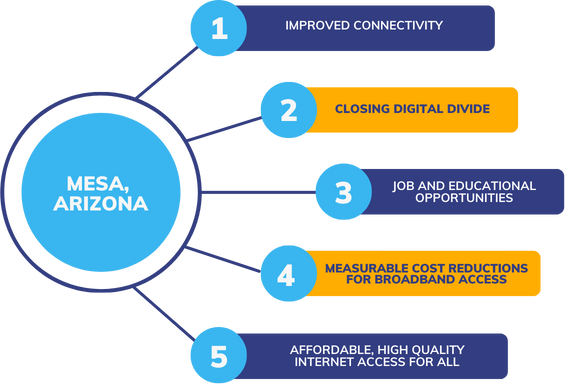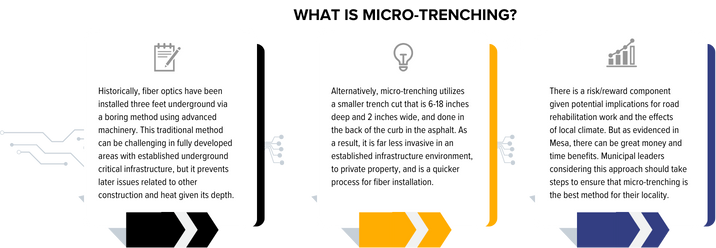Broadband Equity Access and Deployment Program (BEAD) Overview
The BEAD program is unique in the realm of broadband funding as it consists of a two-tiered system in which the National Telecommunications and Information Administration (NTIA) distributes program formula funding to states, who then host subgrant competitions to distribute the funding. BEAD funding is sequenced as an iterative process (detailed in Section IV.B of the BEAD NOFO) to drive resources to states based on review and acceptance of five-year action plans which then guide state proposals including both statewide and municipal initiatives. Subgrant competitions for cities are defined in Volume 2 of the Initial State Proposal. The timeline for BEAD program implementation will vary by state as it is dependent on the timing of other state milestones related to required steps for receiving BEAD funding. At publication, many states’ initial proposals are in the public comments phase. The National Telecommunications and Information Administration has a webpage for public notice postings of BEAD and Digital Equity plans and proposals. State subgrant competitions are expected to be held in CY 2024. With this structure, there is likely to be variance in subgrantee requirements across states.
Considerations for municipal leaders
These case studies raise several considerations for municipal leaders and stakeholders as strategies for broadband deployment are developed, including:
- What are your goals for community connectivity and how do they align with priorities for equity, economic mobility and competitiveness?
- What are the challenges facing your city in terms of closing equity gaps and spurring economic development – physical access, affordability, or something else?
- What is the existing physical infrastructure and who is in the market?
- What funding and financing options are available to your city?
- What local partners do you have or need to build a successful project? How can you best engage with them?
- What is the level of community support? How do community stakeholders see the trade-offs in different models for broadband upgrades?
- What organizations and resources can you work with to provide access to digital technology (including computers) and support digital literacy?
- How will you ensure that eligible households can access benefits provided by the FCC’s Affordable Connectivity Program?
Access to High Speed Internet in Mesa Project

Overview
Project Leadership:
- Mayor John Giles
- Mesa City Council
- Ian Linssen, Assistant to the City Manager
Location: City of Mesa
Focus: Broadband infrastructure, economic mobility
Key Project Info:
This project is wholly paid for by private ISPs, ISPs have considered pursuing federal funding sources.
An initial Request for Information (RFI) was issued in January 2022 with the City receiving seven (7) responses by the March deadline. The City Attorney’s Office then crafted overarching “Fiber License Agreements,” which enable ISPs to access the City’s rights of way for the project. In July 2022, the City Council approved four (4) licensing agreements. As of September 2023, Mesa has three (3) licensed ISPs installing fiber. The project is expected to be completed within the next five (5) years.
In recent years, the City of Mesa has been discussing citywide, high-speed broadband deployment in their quest for digital equity, to ensure that all households and businesses have physical access and an affordable connection to quality broadband. To achieve these important goals, Mesa has partnered with several private internet service providers (ISPs) to enable the installation of fiber optic network facilities in the City’s rights of way. Within Mesa, the ISP networks will be 100% constructed, owned, operated, and paid for by private sector companies. This unique approach on a city-wide scale illustrates the benefits of public-private partnerships and innovative models, guided by clear goals and partner roles, in broadband deployment.
Projected Community Impact

Problem to Solve
The City Council began discussions on the need for deeper city engagement in broadband deployment almost five years ago during a strategic planning process. In 2019, 23.2% of households in Mesa did not have a broadband internet subscription (i.e., cable, fiber optic, or a digital subscriber line), while 7.4% of Mesa households had no internet access. In its quest for digital equity, Mesa wanted to ensure that all households had both physical access and an affordable connection to quality broadband.

The COVID-19 pandemic only affirmed that better connectivity was needed; per the RFI issued in February 2022, “although excellent internet connectivity currently exists within the City [Mesa], the COVID-19 pandemic has made it clear that there remains a stark digital divide preventing many Mesa families from accessing critical education, workforce, and other online services.” Additionally, Mesa needed increased network access and capabilities to continue expanding their smart city offerings such as intelligent traffic systems, free WiFi services in downtown Mesa, and smart irrigation controllers.
Within the RFI, Mesa identified five goals:
- Development of a citywide open-access fiber to the premise network, providing direct connections to all residential and commercial end-users within the City,
- Partners who were willing to continue to grow and invest as new neighborhoods are built within the city,
- Networkwide 1 Gbps internet service available to each premise, with the ability to upgrade to faster speeds in the future (either by the partner or other ISPs on the open-access network),
- City access to and unrestricted use of the full citywide fiber network at zero cost to the city, and
- Offerings of free/affordable high speed internet service (>100 Mbps) to qualifying households via the open-access network.
Community Engagement and Impact
Community Impact
The project is ongoing, and its full impact will be felt over the coming years. To date, Mesa has seen three (3) new providers installing fiber – passing over 30,000 residences. The City has also issued 1,000 miles of conduit permits. Of the 30,000 residences passed, 10% have had their services turned on. Based on anecdotal evidence and community feedback to the City, the most visible impact to date has been reductions in existing bills, including in areas without the new fiber optics.
Over time, the projected impacts include:
- Improved connectivity throughout the city, leading to more work, educational, and social opportunities for Mesa’s 500,000+ residents,
- Measurable reduction in costs for broadband access, and
- Closing the local digital divide by ensuring affordable, high-quality internet access for all residents.
Community Engagement
In Arizona, public utility easements extend eight (8) feet into a resident’s yard, and with the appropriate permit, ISPs can construct within these easements. As part of the fiber licensing and right of way permit requirements, ISPs are expected to notify all homeowners impacted by construction 48 hours prior to construction. To this end, the City has documented ISPs employing door fliers, mailers, and other communication strategies to notify impacted residents; yet it is unclear if those residents always receive the message. These gaps in communications have led to confusion and, sometimes, frustration for residents which the City must step in to resolve.
At the city-level, Mesa has used traditional and regular communication channels to clearly communicate project plans and goals with their residents. Linssen, with the City Manager’s Office, acknowledged that this strategy may not be enough – the biggest question for him is always “how do you get the right information out to the right people?” Going beyond regular channels, the City has relied on community representatives and local neighborhoods’ leadership. For example, through engagement with the Dobson Ranch Homeowners Association, the City made a concerted effort to spread awareness directly to their community members, going beyond social media and other traditional channels to utilize a deeper and more local, trusted line of communication.
Community engagement relating to construction in utility easements will vary across states depending on local regulations, in any case community engagement and resident communication must be a priority for cities.
Pre-Development
Following on the initial discussions for additional connectivity and broadband investments, the City explored the possibility of using a municipal-owned ISP approach, similar to that of Chattanooga. However, Mesa identified two challenges that would prevent this. First, the cost of the approach amounted to $500-800M, about one-third of Mesa’s FY 2022-2023 budget of $2.3B. Given recent bonds issued for water infrastructure investments, the City was not willing to issue more bonds. Second, while the City has a municipal electric and water utility, as well as natural gas services, they did not have sufficient technical expertise necessary to establish and operate a municipally-owned ISP.
Mesa issued an RFI that outlined their goals for the broadband project and intentionally utilized broad language to enable the City to “learn from the market.” After receiving seven (7) responses to the RFI, the City Council decided, instead of picking a single provider for a partnership, that they would open up the market to multiple ISPs and allow for increased competition. Following on this, the City assembled a “Fiber Optic Provider Toolkit” that included a ‘modern right-of-way license and fee structure and remained open to new construction methodologies that would be less invasive and enable faster deployment. The City ultimately granted licenses to five (5) providers.
Through the RFI process, Mesa City leaders recognized that their best path forward was to allow the market to lead and innovate. For example, the city’s RFI indicated an openness to consider alternative methods to laying fiber, such as micro-trenching – an approach favored by the ISPs given its less invasive nature (see insert), albeit there are risks associated with the approach. “After we reviewed the responses,” Ian Linssen said, “it was clear that in order for some of the builds to work, micro-trenching was essential.”
The license agreement also includes a clause whereby ISPs should coordinate with other utilities, as possible, to enable joint trenching efforts and common trench installations.

Partner Engagement
At the City level, the Council and City Manager worked to develop the necessary policies to kickstart the discussion and enable the market-driven approach. This entailed developing an innovative fee structure for usage of public utility rights-of-way and enabling innovative methods, such as micro-trenching. To facilitate the partnership between public and private interests, the City and ISPs entered into “Fiber License Agreements” that were approved by the City Council and executed by the City Manager’s office.
Per the “Fiber License Agreements,” as crafted by the City Attorney’s office, approved by Mesa City Council, and executed by the City Manager, ISP-licensees have a “revocable and non-exclusive license to erect, construct, repair, maintain, replace, operate, lease, install, remove, reconstruct, and upgrade” the fiber network along and across public roads in the City of Mesa, for the purposes of providing “a fiber-based, wholesale broadband access service.” Per the arrangement, ISP-licensees are solely responsible for all of the costs associated with these activities. These licenses enable ISPs to access Mesa’s rights of way. The rights and privileges granted by the agreements are in effect for an initial five-year term, unless the agreement is revoked or canceled (per terms laid out in the agreement). License agreements are then automatically renewed at the end of each five-year term. If an ISP chooses not to renew or transfer the license within six months of its expiration date, then their network is deemed abandoned and becomes property of the City (with limited exceptions).

Following the approval of the initial licensing agreements with the ISPs, the City’s engagement with those ISPs has primarily come through the right of way permitting process, as managed by the City’s Right of Way Division nested in their Engineering Department. The license agreements include a provision, where if an ISP-licensee “desires greater control over the speed of the permitting process” then the licensee may request that the City hire an independent consultant to work alongside City staff who is solely dedicated to the processing of that licensee’s permit applications. The ISPs that have entered these agreements are responsible for reimbursing the City directly for the associated costs of hiring the external consultant. To execute these agreements, the City works under existing professional services contracts they hold, using previously negotiated rates. Through this approach, the ISPs are able to process permits and connect more Mesa residents to services faster, at no additional cost to the City or extra undue burden to permitting staff.
While the project is largely predicated upon the formation of new ISP partnerships, the prospect of new competition has helped to further develop Mesa’s partnership with their incumbent service providers as well. Mesa knew that concessions and support they offered to new ISPs also needed to be offered to the incumbent: “Anything we were doing for a new [ISP], we wanted to ensure we were doing or will do for our current [ISPs],” Linssen said.
This project also dictated that the City of Mesa engage closely with the other utility providers owning and operating existing infrastructure in the public utility easement/right of way. Each facility or land owner has their own, independent permitting process; ISPs have to engage with the City’s Right of Way Division for public rights of way permits and with separate land or facility owners for work around their facilities.
Project Funding
As a result of the partnership structure, the City is not having to use any state or federal funding. Linssen noted that ISPs have expressed an interest in pursuing funding from the NTIA’s slate of Bipartisan Infrastructure Law programs, such as the Broadband Equity, Access, and Deployment (BEAD) Program.
Traditionally, for usage of publicly controlled rights of way and utility easements, the City requires the payment of an “Annual Right-of-Way Underground Conduit Fee.” However, due to the estimated costs of this on ISPs for the entire City ($22-25M per year for each ISP that covers the city), the City of Mesa provided another option for the fee structure in the License Agreement; licensees can opt to pay 2% of their gross revenue from the network in lieu of the standard annual fee. Incumbent telecommunications providers were previously paying a rate about five to ten (5-10) times higher than the new fee structure.
Conclusion
Within the next five (5) years, in-line with Mesa’s projected timeline, the whole city will be connected via the open-access fiber network through multiple ISPs, increasing market competition and, thereby, choice and access to affordable, high-speed broadband for the city’s residents.
To meet the goals and timeline, Mesa must overcome challenges relating to the physical locations of infrastructure for the network, processing right-of-way permits, and workforce limitations.
While Mesa’s expansion of ISP partnerships and use of private funds for broadband expansion are not directly reflective of the opportunities and programs that will be provided through the states’ BEAD funding allocations, the aspirations of their efforts are – more residents, connected to higher-quality affordable broadband through coordinated, good-faith partnerships. And, with so many questions about the availability of BEAD funds and their use cases still to be answered, Mesa is taking control of their residents’ connectivity opportunities. Mesa took innovative steps in their partnerships with ISPs to rethink the methodologies for laying fiber more quickly through their use of micro-trenching, hiring dedicated staff for each providers’ permitting needs, and ensuring incumbent provider relationships were strengthened, not lost, through the formation of new ones.
As Arizona’s BEAD and other broadband expansion programs are announced and funds begin to move, Mesa and their ISP partners will already be on the way toward those programs’ aims, maximizing their impact that much further.
Accelerator for America would like to thank Drexel University Nowak Metro Finance Lab for their partnership in production of this case story for the Local Infrastructure Hub.



